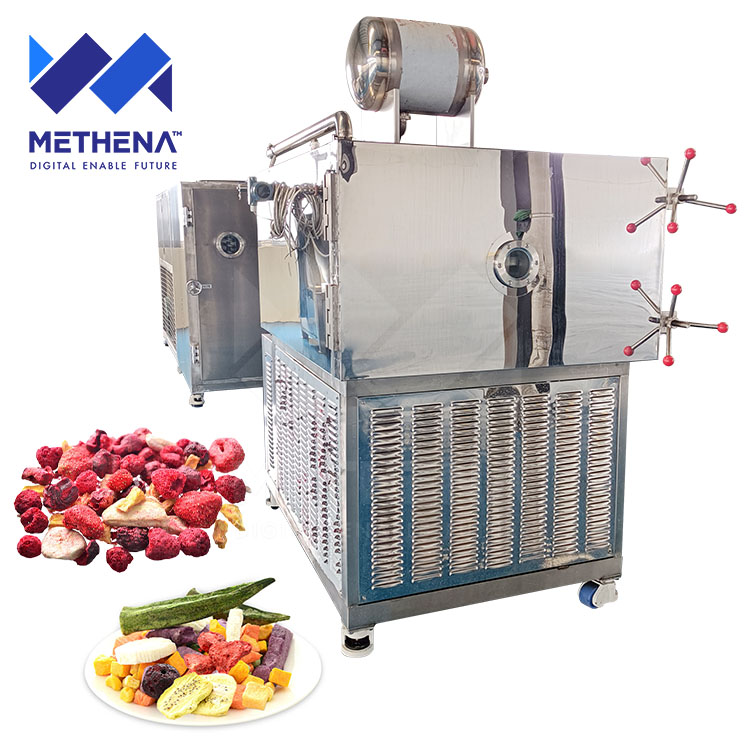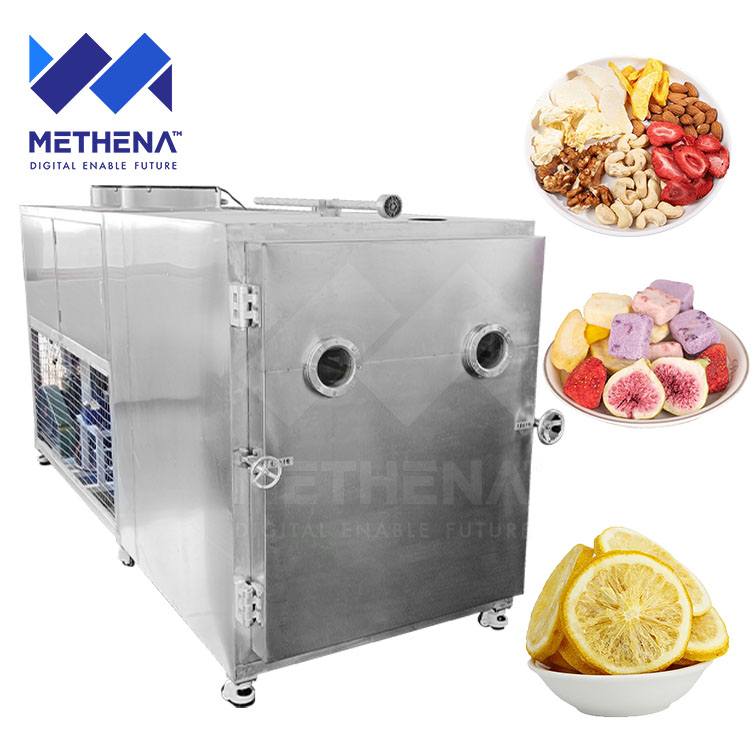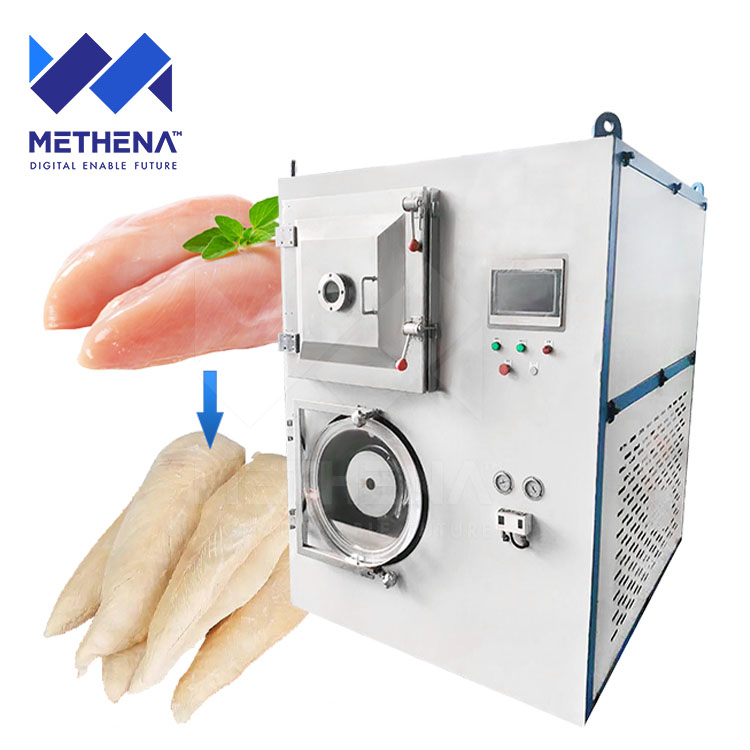A freeze dryer is an efficient device that removes moisture from food or pharmaceuticals. The process involves first freezing the material to ultra-low temperatures, then using vacuum technology to directly sublimate the ice into water vapor, and finally drying the material to transform it into a freeze-dried state. This method not only preserves the nutritional content and original flavor of the food but also significantly reduces the volume of the material, making it easier to carry and transport.


Working Principle of a Freeze Dryer
how does a freeze dryer work?
The working principle of a freeze dryer can be divided into four main steps:
Freezing
The material to be freeze-dried needs to be cooled to extremely low temperatures below -40°C, freezing the moisture within the material into ice and turning the material into a solid state.
Vacuum Sublimation
The solidified material is placed into a vacuum environment under low temperature, where the ice within the solid material directly turns into water vapor. This step is achieved by the freeze dryer controlling both temperature and pressure.
Condensation of Water Vapor
The water vapor formed from the material needs to be condensed. After condensation, the ice is removed, further reducing the moisture content.
Secondary Drying
After condensation, most of the moisture has been removed, but some "bound water" may still remain. At this stage, the temperature is raised while maintaining the low-pressure environment to further dry the material, allowing the remaining bound water to evaporate as much as possible.
After these four steps, the material will transform into a freeze-dried form that is much smaller in volume and weight compared to the original. This not only extends the shelf life but also makes transportation more convenient.
Freeze Drying Technology vs Hot Air Drying Technology
Principle of Operation:
Freeze Drying Technology:
This process primarily involves the sublimation of moisture from solid to gas under low temperature and vacuum conditions, without passing through the liquid phase. This method helps preserve the original structure and better retains all the substances contained in the material.
Hot Air Drying Technology:
This process mainly relies on hot air generated by high temperatures to evaporate moisture. The heat causes moisture to evaporate into water vapor, and the ventilation system is used to blow away the vapor, achieving the drying effect.
Application Fields:


Application Fields of Freeze Drying Technology:
Since freeze drying technology achieves dehydration through the sublimation of water, it avoids the liquid phase. This process helps preserve the material’s structure and retain all its substances, making it particularly suitable for fields like pharmaceuticals and chemical research, where biological activity must be maintained.
Application Fields of Hot Air Drying Technology:
Hot air drying technology uses hot air to evaporate moisture. By applying high temperatures, the moisture is turned into steam, which is then removed through a ventilation system. This method is primarily used in commercial, industrial, pharmaceutical, and food industries, and is suitable for drying applications where maintaining biological activity is not a requirement.
Freeze-drying Technology Advantages and Disadvantages:
Advantages:
Preserves Original Form and Flavor: Afterfreeze-drying,the moisture inside the material evaporates, causing it to shrink in volume, but the external appearance remains unchanged. The texture and aroma of the frozen material, as it is not subjected to high-temperature baking, retain their original taste and fragrance, making it safe to enjoy. In fact, in many freeze-drying videos, if water is added, the freeze-dried food will expand and return to its original state after some time.
Maximizes Nutrient Retention: Since freeze-drying does not involve high-temperature baking, it does not destroy vitamins or other nutrients present in the material. This process effectively locks in the nutritional content of the substance.
Prolongs Shelf Life and Facilitates Storage: By drying the moisture from the material, its shelf life is extended, making it easier to store. Freeze-dried foods and medicines do not need to worry about decay or preservation issues and do not require refrigeration, effectively lowering costs and minimizing unnecessary risks.
Suitable for Long-Distance Transportation: The volume and weight of the material after freeze-drying are significantly reduced compared to its original size, greatly saving space for transportation. This makes it ideal for long-term storage and shipping needs.
Disadvantages:
The best equipment and price is high: While freeze-drying can largely preserve the original form and nutritional value of materials, the equipment required is complex and the costs are higher. The more detailed the material processing, the longer the time it takes compared to hot air drying.
Hot Air Drying Technology: Advantages and Disadvantages
Advantages:
The equipment is simple and easy to use, the main thing is that the price is cheap
The drying time is shorter compared to freeze-drying.
It is more suitable for heat-resistant materials, such as fruits and nuts.
Disadvantages:
Although the hot air drying technology offers simple equipment configuration, low costs, and faster drying times, it can damage the original nutritional content of the material. The texture of the dried product is generally inferior to the original. Most importantly, materials dried with hot air have a higher moisture content compared to those dried through freeze-drying, which results in a lower moisture content.
Important Factors to Consider When Choosing a Freeze Dryer
Production Scale: Choose equipment based on production capacity requirements, type, and size of the equipment. If the freeze dryer is intended for use in industries dealing with heat-sensitive materials or for research purposes, a laboratory-type freeze dryer will suffice. For large-scale food or seafood freeze-drying industries, a large automated freeze dryer is more suitable, offering efficiency and stability.
Specific Characteristics of the Material: If the freeze-dried material requires maintaining its original form and nutritional content, such as in the food processing industry, you need to select a freeze dryer according to the production scale. For medical research requiring the preservation of biological states, specialized laboratory freeze dryers should be used. If the goal is to freeze-dry materials like fruit juices, a specialized spray freeze dryer is necessary.
Budget: After understanding the production scale and material sample requirements, choose a freeze dryer that fits your budget. If you have a sufficient budget, select a machine that meets your requirements and offers higher configurations. If the budget is limited but the machine is essential, you can reduce the size of the equipment and customize it accordingly. Ultimately, the decision is up to you.
Test the Equipment's Performance: The most critical steps in freeze-drying are freezing, vacuum condensation, and temperature-controlled drying.
First, the freezing efficiency and effectiveness directly determine the speed of freeze-drying.
Second, the precise temperature control during vacuum formation and water vapor condensation affects the moisture content in the freeze-dried material.
Therefore, freezing speed and accurate temperature control are crucial.
Observe the Quality of the Equipment: The material of the equipment should be made of high-corrosion-resistant stainless steel for easy cleaning and sanitation. Hygiene is also very important.
The manufacturing process of the equipment and the ease of use of the operation control panel are essential for precise control. Language switching and touch technology will significantly increase the complexity of operation.
Quality of Equipment Components: The quality of equipment accessories directly affects the production capacity of materials. When the accessories are durable, it improves work efficiency, increases production, and saves costs. If there are easily worn accessories that can be given away as a giveaway to your suppliers, that would be ideal.
After-Sales Service:
Technical Support:Does the equipment have dedicated technical personnel for installation and troubleshooting?
Maintenance: Consider the maintenance, warranty period, and repair costs to ensure they are within your budget range.
Training Services:Training for equipment operation and daily maintenance is essential. Given the high cost of such equipment, these training sessions can help you avoid unnecessary expenses.
Choosing the Right Supplier
Choosing the right supplier is important, and can be approached from the following points:
Clarify Your Needs:
First, gather information on suppliers in your industry and clearly define your requirements.
Select Suppliers:
After clarifying your needs, when selecting multiple suppliers, consider factors such as the supplier’s reputation, customer reviews, their reputation within the industry, whether their equipment quality and service level meet standards, and whether they have a professional technical team that can directly provide expert guidance and solve practical issues.
Compare Potential Suppliers:
Conduct a comprehensive comparison of the selected suppliers, considering not only their differences but also the potential for long-term cooperation and development. Think about whether you can establish a mutually beneficial, win-win long-term partnership.
This translation retains the original meaning without changing the context.
Here are several typical common issues with freeze dryers and their solutions:
Excessive Moisture Content in Freeze-Dried Products:
The cause of this problem is typically due to high temperature during the sublimation process, insufficient vacuum pressure, and a short drying time.
Solution: Lower the sublimation temperature, increase the vacuum level, and extend the drying time. Regular attention should be given to temperature control and the cleaning and maintenance of the vacuum pump.
Material Melting, Low Vacuum Pressure:
This is usually caused by high temperatures in the pre-freezing system or worn seals in the vacuum system that need replacement.
Solution: Lower the temperature in the pre-freezing system and regularly check and replace worn parts of the vacuum pump.
Conclusion
When choosing a freeze dryer, it is important to consider various factors such as budget, installation, maintenance, operation, capacity, and technical support before making a final decision.



